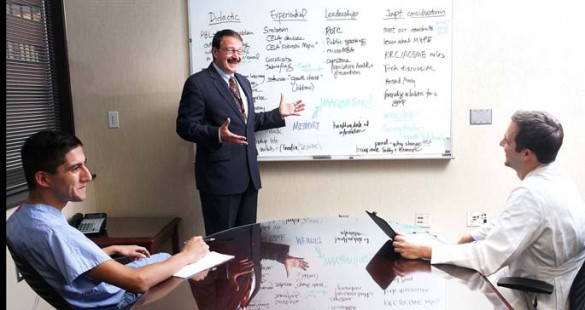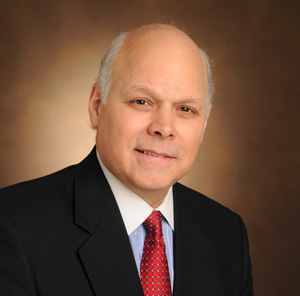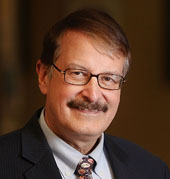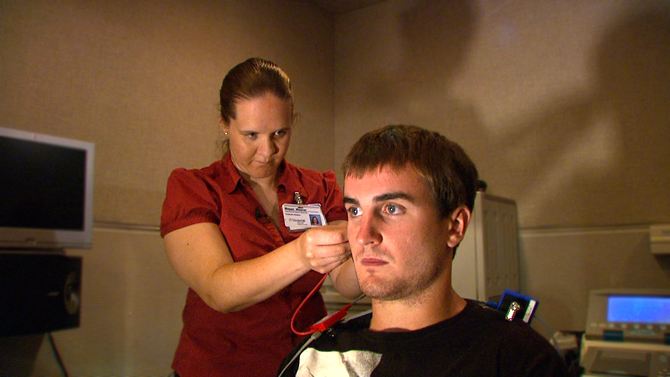
When Vanderbilt Bill Wilkerson Center director Roland Eavey, M.D., learned of the institution’s prioritized focus on training the next generation of leaders he went to two organizations he knew that were famous for doing that — the military and business schools.
Four years later, Eavey published an article about his innovative program for Otolaryngology residents in the inaugural issue of Leading Health Care Innovation, a collaboration of the editors of the Harvard Business Review and the New England Journal of Medicine.
The blog “Military Leadership Lessons for Training Doctors,” is an important element of the eight-week online forum devoted to helping leaders, managers and others in health care increase value by improving patient outcomes and reducing costs.
“You can train most people to be leaders. It’s like training them to jump rope or tie their shoes. It is doable. So we must do it,” said Eavey, the Guy M. Maness Professor and chair of the Department of Otolaryngology and executive medical director of the Vanderbilt Employee Health Plan. “So I figured that if we are serious about this we are not just going to give it lip service. We will have to invent a leadership program.
Eavey began discussing the idea with Capt. James “Jamie” Hopkins, commanding officer of the Vanderbilt Naval Reserve Officer Training Corps (NROTC), and the two quickly discovered common ground in their missions.
“He didn’t know anything about medicine and I didn’t know anything about the military. Yet we realized that both are big organizations, so we have similar organizational challenges, even if our missions are very different. We need to serve and lead a lot of different people to accomplish vital behavioral goals.”
The resulting four-year Leadership Training Program for Otolaryngology residents consists of NROTC (10 hours), followed by public speaking (eight hours), a micro-MBA (18 hours) and a capstone leadership project on community disease prevention.
“We pulled together an outstanding ensemble of people,” Eavey said. “The idea was to expose the residents to individuals to whom they wouldn’t normally have access. That gives them a chance to picture themselves as one of those leaders.
“The lessons we learned were pretty important for their careers, as health care will evolve rapidly and new tools will be necessary.”
Eavey said the NROTC, for example, was surprised to learn that doctors typically might not be taught basic communications skills, which is now a focus for Vanderbilt Otolaryngology residents.
“The harried doctor might enter in a hurry, wiping anti-bacterial foam, so he doesn’t necessarily shake hands, and devote ever more attention to the computer — and that has happened to a lot of us,” Eavey said.
“The NROTC says that communication is basic for them. You mold these 18-year-olds and tell them to stand up when someone comes in the room, shake hands, make eye contact and use some basic communication skills.”
The Otolaryngology residents are now taught fundamental patient interaction skills through simulated patient experiences at CELA with real actors, whether for routine care or for a dreaded explanation that a loved one has passed away unexpectedly on the operating room table.
Further, since residents in their career will need to speak at large venues, eight hours of public speaking sessions were provided by Thomas Cleveland, Ph.D., of the Vanderbilt Voice Center.
Under the tab of Quality and Safety, the resident program is developing a formal post-operative debriefing for faculty and trainees.
The micro-MBA exposes the trainees to new topics and real leaders. For example, ‘decision making’ was led by an U.S. Air Force colonel and ‘conflict resolution’ by a minister. Prominent individuals from national organizations such as Kaiser Permanente of Southern California (Oliver Goldsmith), Partners Healthcare in Boston (Tom Lee and Martha Weinberg) and Vanderbilt led several two-hour sessions.
The Otolaryngology training program uses the novel didactic learning style developed at business schools, with lectures nearly eliminated. Instead, advance readings and preparation, active team learning, audience response systems, enhanced retention methods including phone apps, and Bloom’s Taxonomy as an intellectual platform are emphasized.
“The residents requested last year, practically demanded, through a unanimous secret vote, to accelerate and intensify the educational changes. The session hours devoted to this new didactic style were quadrupled to accommodate the resident request – their appreciation for this pedagogy is striking since this method of education is much more time-intensive for each participant,” Eavey said.
“Our annual resident rankings reveal a satisfaction for our training efforts at 100 percent — far above the national average. We are fortunate that our resident-level training efforts are congruent within our larger medical school culture. The word ‘doctor’ means both ‘teacher’ and ‘leader.’ Vanderbilt takes both meanings seriously.”
Here are the five lessons mentioned in Eavey’s blog:
Lesson 1: Medicine should focus on fundamental communication skills in addition to complex science and technology.
Lesson 2: Medicine’s ‘Top Guns’ (such as a great surgeon or respected researcher) do not always automatically enjoy nor perform well in leadership roles.
Lesson 3: Medicine needs to expand selection criteria for promotion as well as to train individuals to take on the next responsibility:
Lesson 4: Medicine can do better regarding Quality and Safety
Lesson 5: Medicine needs to reflect on perpetuation.















